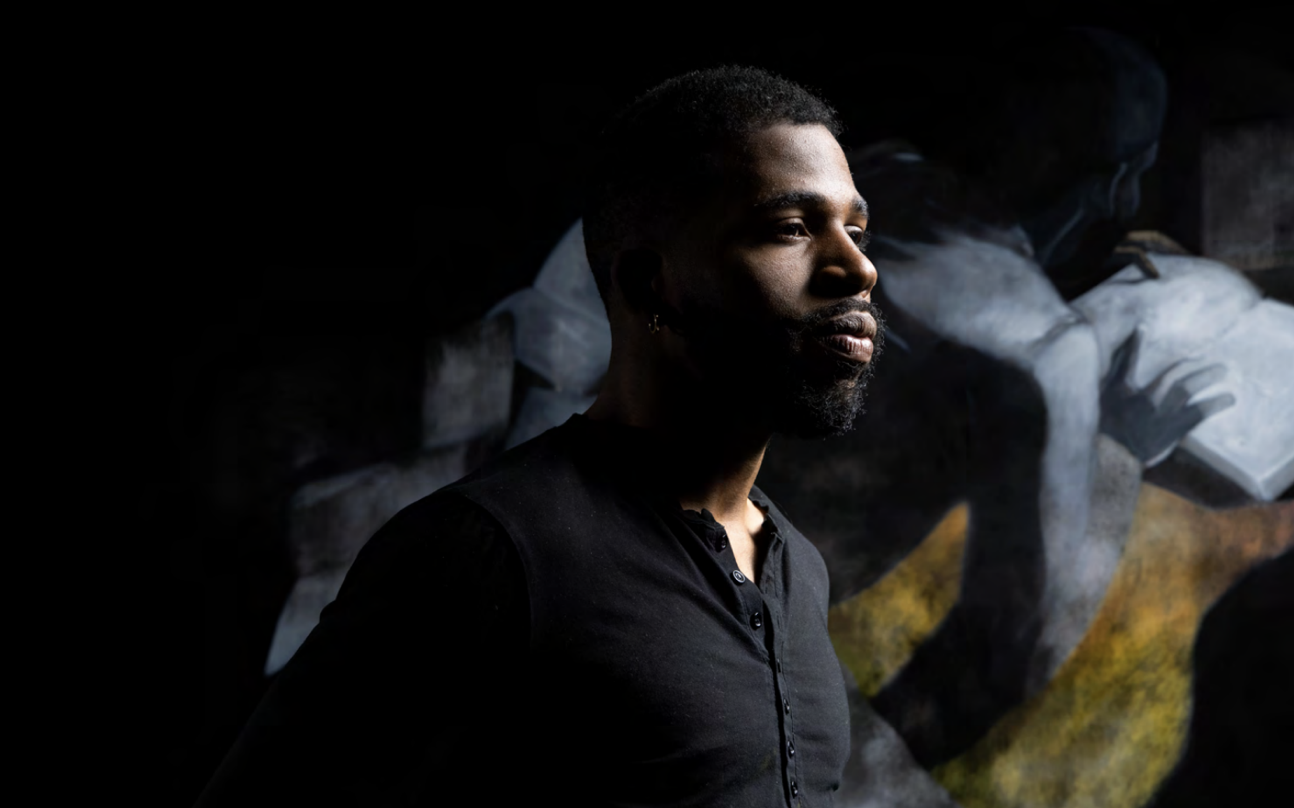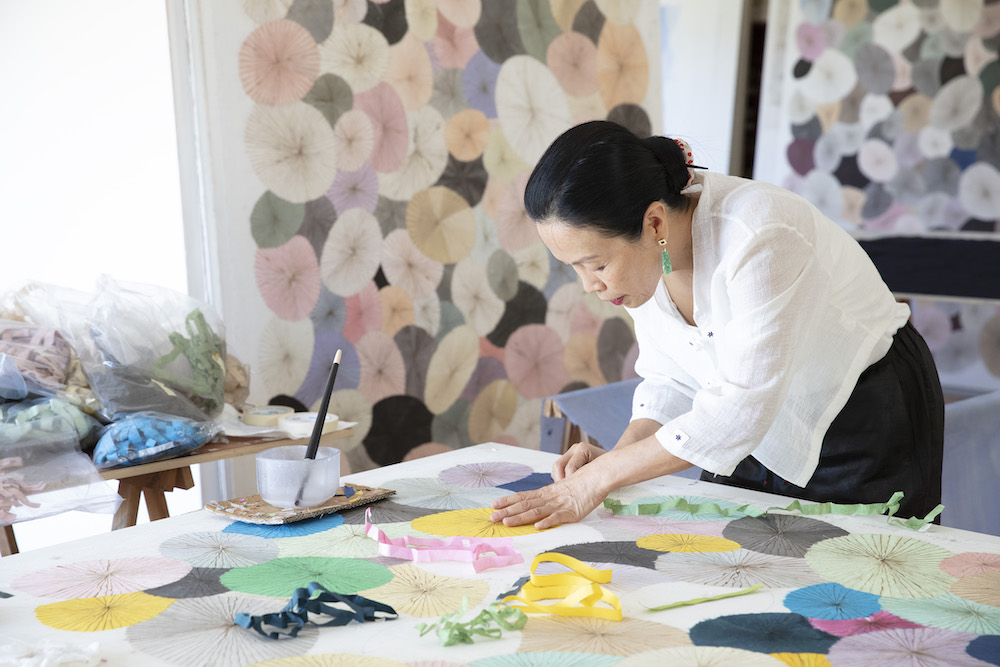In February, Lehmann Maupin in New York held a solo presentation of new work by Dominic Chambers, who recently joined the gallery. Entitled “Soft Shadows,” the paintings engage themes of psychology, memory, personal history, and more. The New Haven–based artist is known for his adept use of color and knowledge of color theory. His palette as of late is more subdued, darker in tone, and hazier in gray and gold. In these new paintings there’s a figure splayed out across a pile of books, immersed in a text; an empty park at dusk with a house on the horizon; a stairway to nowhere populated by less and less visible, almost ghostly figures.
The works speak to Chambers’s emotional response to our current moment, while offering a gesture of protection. He is an avid reader, and his research and study directly inspire his process and painting, like the writings of Susan Cain, W.E.B. Du Bois, and Carl Jung. Exploring the intersection between the Black experience and surrealism, the artist continues to question our troubled relationship with rest, and those who’ve been historically depicted in repose.
WHITEWALL: Can you tell us about your “Shadow Work” series, some of which was recently presented at Lehmann Maupin in New York?
DOMINIC CHAMBERS: The “Shadow Work” paintings are a series of self-portraits that began as meditations. They represent changes I felt within myself in response to the pandemic, familial loss, and our complicated and messy political climate. The gesture of the hand over the shoulder can be interpreted as a comforting gesture. However, I hope that the gesture is also reminiscent of the laying of the hands that members of a church congregation would perform to invoke spiritual protection. My nails are also painted a specific shade of blue called haint blue, a color that Southern Blacks would paint the color of their window shutters, ceilings, rooftops, and sometimes their entire home to ward off evil spirits. That was the sort of protection I felt that we all needed.
I have also been looking a lot at Johannes Vermeer. Shadow Work #2, for example, makes reference to Vermeer’s “Girl with a Pearl Earring”. The positioning of the body, the fat black background, and the heightened luminosity of the earring are all intended to point to Vermeer’s work. Girl with a Pearl Earring appeals to me not only because of its formal execution but also because of what it represents in a larger historical context. I love that a painting can be emblematic of a change in time.
WW: How did you become interested in the psychology term “shadow work”?
DC: I became interested in shadow work last winter, actually. I was reading Quiet: The Power of Introverts in a World That Can’t Stop Talking by Susan Cain, and she mentions Carl Jung, the Swiss psychiatrist who is responsible for developing analytical psychology. While reading up on some of Jung’s work, I learned that he’s also responsible for popularizing the idea of the shadow self. Jung theorized that encountering the shadow self is the first step to becoming whole and that the shadow self contains the aspects of our identity that we reject or suppress. That is what shadow work is: the interrogation or examination of our seemingly less-than-desirable selves. In a way, the process is one of becoming a more coherent self. But to do that, we have to reconcile our own personal histories, which is why therapy is so important. I feel like America could benefit from doing shadow work.
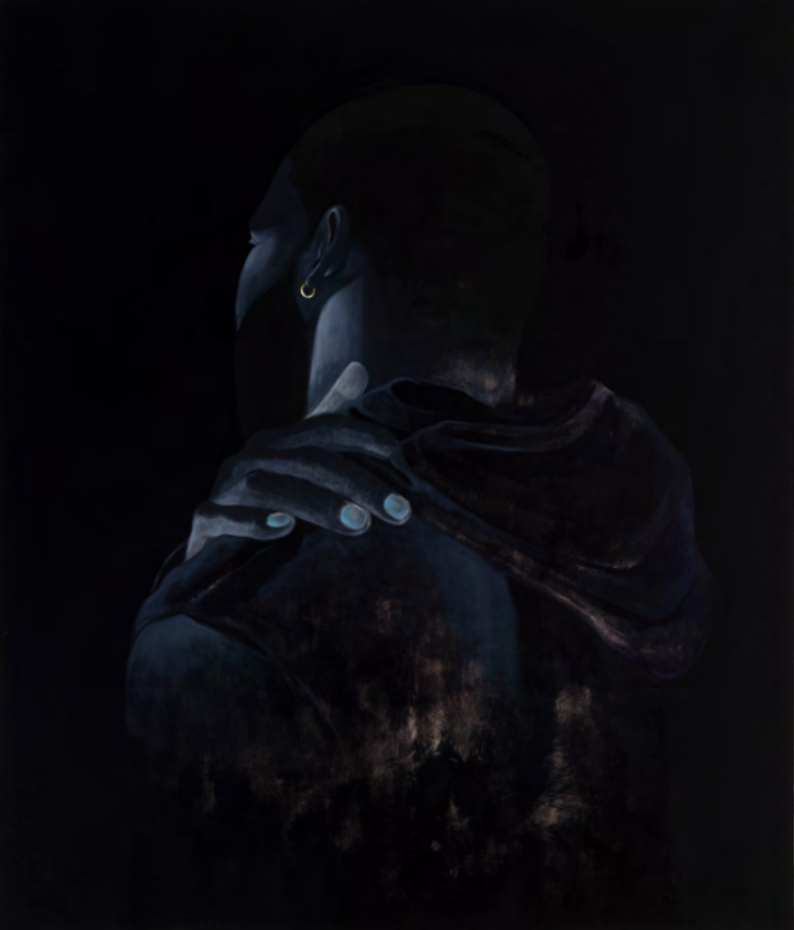
Dominic Chambers, Shadow Work (On Letting Go), 2021, oil on linen, 66 x 56 inches, courtesy of the artist and Lehmann Maupin, New York, Hong Kong, Seoul, and London.
WW: How does the theme you are exploring in a piece inform the color choice?
DC: I’m interested in color in and of itself. The ideas or concerns that I may have before starting a painting don’t always influence the colors I’ll use; in fact, it is often the other way around. For example, I’ll start a painting thinking about the color yellow, which is a notoriously difficult color to use because of its thin opacity when applied. What follows is a series of questions about which combinations of hues will be the most effective for building my image.
Also, the way I use color in different series of works varies. For instance, in the wash paintings, I make my images with the understanding that most of what I am working on will likely be lost. Once I have poured and brushed paint over the initial image, I have a new ground, so to speak. The wash then becomes like a body. It becomes the exterior, and I have to ask myself: “What are the characteristics of that exterior? Is it heavy? Is it luminous? Is it textured and varied? How does light interact with this new surface that I made for myself?” It’s those kinds of questions that have an impact on my palette when producing the wash paintings. Every painting has a different set of needs, and those needs provoke questions that keep the process exciting.
WW: Your show “Progress of the Soul” was previously on view at Luce Gallery. Can you tell us about what it was like to focus on self-portraits for those works?
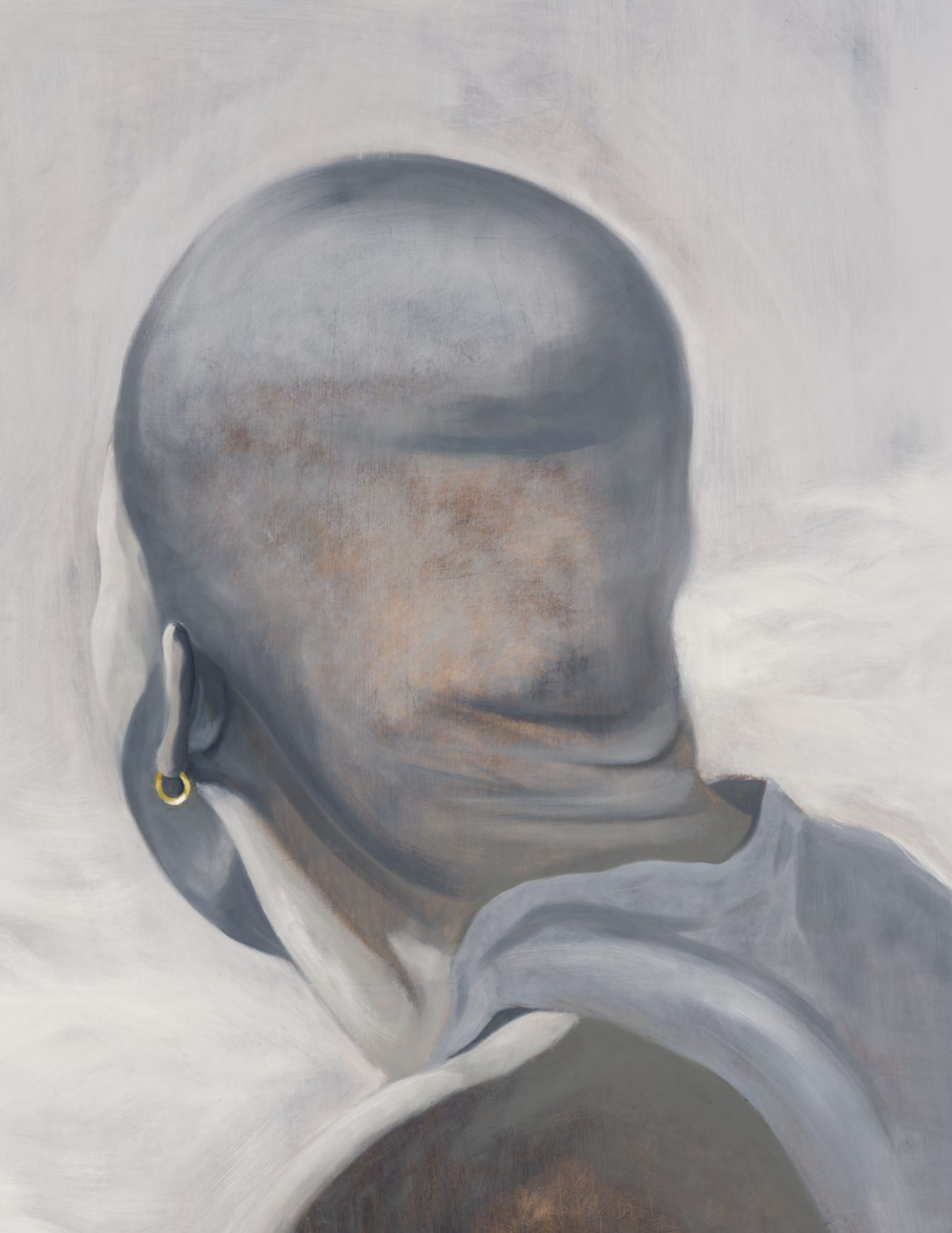
Dominic Chambers, Untitled (Study for Shadow Work), 2021, oil on linen, 40 x 35 inches, courtesy the artist and Lehmann Maupin, New York, Hong Kong, Seoul, and London.
DC: It was definitely a little weird because I kept changing things about myself in the paintings. But once I put myself aside, I approach the “me” in the paintings as another subject, a familiar one, but certainly nothing to overstate. Those works are still very much about studying color, surface, and light. I have to figure out how to make those paintings function effectively and formally too.
WW: You’ve said of previous self-portraits that you’re interested in exploring double consciousness in the studio, how artists approach the work. In working on self-portraits, what did you learn about your approach to painting?
DC: For me, the framework of double consciousness extends into the studio as a reminder to remain true to one’s own voice. It’s not entirely dissimilar from what Philip Guston describes as the studio ghosts: the lingering presence of past experiences, current circumstances, and future desires that occupy and enshroud the artist’s consciousness while in the studio space. From these portraits, I’ve learned that while I am constantly changing and evolving as a painter, my approach to painting has been pretty consistent, and I am happy to say so. As a painter, I approach my practice optimistically. I’m optimistic that I’ll always learn something.
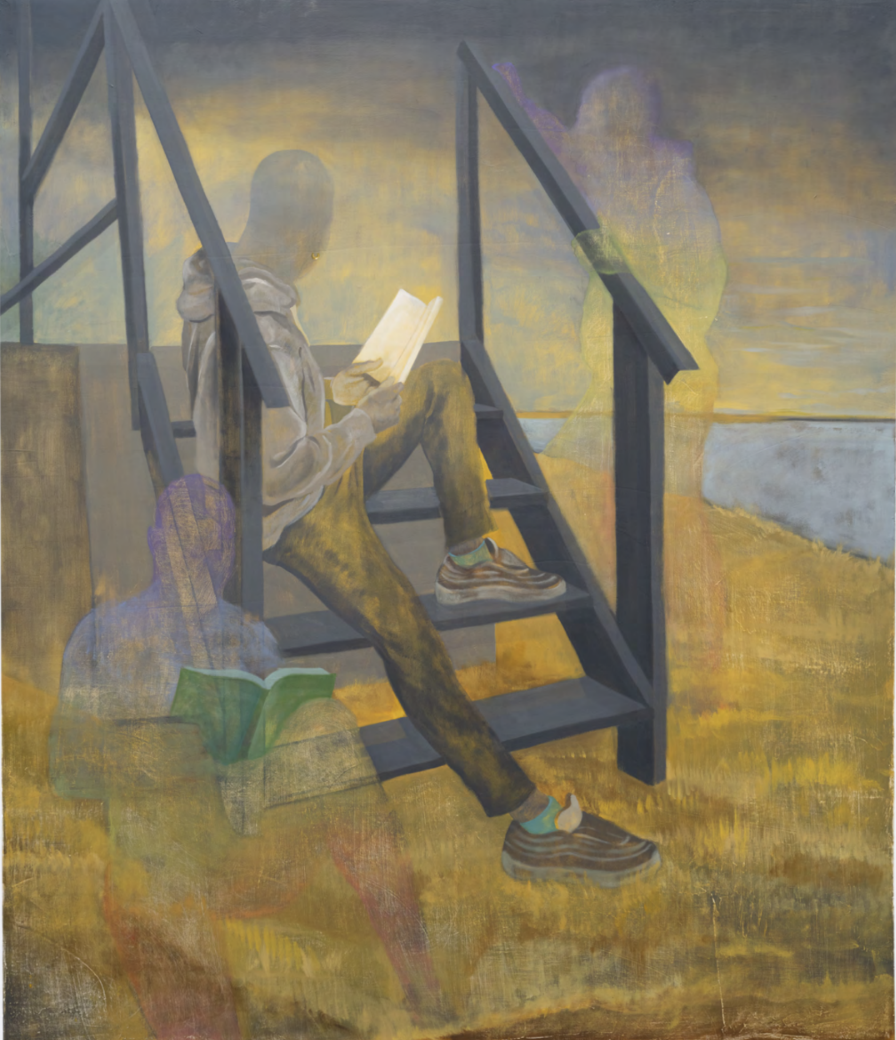
Dominic Chambers, Self-Summoning (shadow work), 2022, oil on linen, 84 x 72 inches, courtesy the artist and Lehmann Maupin, New York, Hong Kong, Seoul, and London.
WW: Bodies at rest or daydreaming have also been a major focus for you. What interests you in capturing this state of rest and contemplation?
DC: One of the things I have been most invested in is a depiction of Black people in states of repose because there is no lens in which to view the Black body as a body capable of rest. That isn’t the established relationship we have with Black people. From the moment enslaved Africans arrived in the colonies in 1619, the context within which Black people have been understood has been that of labor. Historically, if not used as tools for slave labor, Black people have used their bodies to labor for liberation and equality. Historically, Black people aren’t represented as thinkers in paintings. There aren’t depictions of Black people who read. As a lover of books, history, and ideas, I feel a responsibility to represent my community as such.
Honestly, though, I think our relationship to rest is compromised collectively. We live in a society in which our self-worth is completely relational to our societal contributions. Capitalism requires us to sacrifice our mental, spiritual, and physical well-being in order to be seen as valuable human beings. Our history, this maniacal relationship between labor and bodies, has damaged our ability to imagine what rest looks like. This is why images of Black people in moments of contemplation are essential so that we can begin to heal that damage.
WW: How do you hope the viewer considers these works and their own relationship to stillness?
DC: I suppose I hope that my work reminds people to appreciate quieter moments. You know, a weird hope of mine is that in front of the work, a viewer will remain still because that’s what the subject in the painting is doing. Like for a moment you’re doing nothing together.
WW: Is that something you also allow for yourself?
DC: To be honest, not entirely. It feels like I’ve been crazy busy these last couple of years. Also, I’m a studio rat. I love to work. However, I do plan on taking some time to myself soon. There are so many things that I want to catch up on, and people I want to catch up with. There’s always something brewing. But for the time being, I’m looking forward to painting. Resting. And painting some more.


